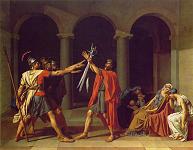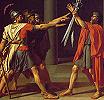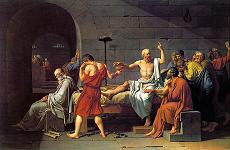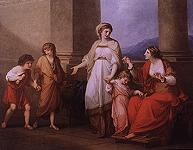Neo-Classical Art |
Neo-Classical Art |
By the last quarter of the 18th century a new style emerged, one that artists embraced throughout western Europe. Whereas literary artists had looked to Greece and Rome for models earlier in the century, painters and sculptors rediscovered classical art much later in the century. A number of things helped prompt this interest: archaeological excavations at Pompeii and Herculaneum; a number of books (with engravings) by travelers to Greece; and by the influence of Winkelmann (the first art historian) who said the main qualities of Greek art were "noble simplicity and quiet grandeur." Neoclassical artists then tried to paint and sculpt these qualities. In addition, artists often drew their subjects from Plutarch's Lives and other Roman works about the noble simple Romans of the Republican period. Neo-classical art is often didactic -- it stresses ethical themes.
Not only did Neo-classical artists draw their subjects from classical history and myth, but they attempted to imitate classical bas-relief sculpture. This meant that paintings were rational and orderly, with figures lined up parallel to the picture plane and with limited spatial recession. Jacques-Louis David is the best example of this new style.
|
Jacques-Louis David (1748-1825)
|
|
|
The Oath of the Horatii 1784
|
|

|
This large painting (11 x 14') is an almost perfect example of neo-classical art. The story, from a classical source, is moralizing and didactic. The style and composition are classical. When this painting was shown in 1784, it received much exaggerated praise; David was called a Messiah in painting and this work was described as the most beautiful painting of the century.
Here the Horatii brothers are swearing an oath that they will fight to the death against the Curatii in a contest over who will rule Alba. One of the women in the painting is a Curatii married to one of the Horatii brothers and one of the Horatii women is engaged to a Curatii. While the weak women lament the possibility of bloodshed, the men recognize their patriotic duty. The message of the painting is that violence and the sacrifice of one's life for one's country are necessary obligations. This message was so powerful that this painting was exhibited again after the French Revolution began four years later. The painting was seen as supporting the Revolution. By then this message was not merely painted rhetoric, but a reality. French Revolutionaries were willing to die for their cause as well as commit any violent acts to further their aims.
|

|
The style of the painting is also typically neo-classical. Not only is the story from a Roman source but several of the figures were copied from antique models. The father's head, for example, is based on the equestrian statue of Marcus Aurelius.
The figures too are sculpturesque; contrast these statuesque males with the elegant dandies in Rococo painting. The male figures have taut muscles and determined gazes and the repetition of the male forms symbolizes their unity and seriousness. The graceful and sensuous lines on the women's side of the painting indicates their weakness and emotion as opposed to male heroism and rationality. The composition is also neo-classical. It is clear and orderly, with figures lined up parallel to the picture plan. The scene exists in a three-dimensional box-space; the viewer's eye is not permitted to wander in the distance since the background is cut off. Everything is composed to direct attention to the three sword hilts at the center of the painting. The setting too is neo-classical -- severe and austere. The architecture is plain with pure geometries. Instead of the glitter of Rococo paintings or the theatrical illumination of Baroque paintings, the light here is flat. Cool and clear, the light defines figures and emphasizes the theme. Similarly, color is austere -- there is none of the pastel softness of Rococo art. Whereas Rococo art is often defined as feminine, neo-classical art is often described as "manly."
|
|
The Death of Socrates 1787
|
|

|
Apply the definitions given above of neo-classical art to this painting, which depicts Socrates willingly drinking the hemlock -- a subject you read about in Humanities I.
Is this painting by David also typically neo-classical?
|
|
Angelica Kauffman (1741-1807)
|
|
|
Cornelia, Mother of the Gracchi 1785
|
|

|
Women also practiced this so-called "manly" neo-classical style. Angelica Kauffman, an internationally known artist in her time, depicts a story about a noble Roman woman, Cornelia. A friend has just shown Cornelia her jewels and asks where her own jewels are. Cornelia points to her children saying "These are my jewels." Not only is the story from classical history, but the painting style is also neo-classical -- with sculptural figures (that have Greek faces) lined up almost parallel to the picture plane, and with a classical setting and clearly defined box space.
|
Neo-classicism was a very important artistic movement, living on into the nineteenth century. The story of the most important neo-classical painter David also continues beyond the French Revolution, when his style can no longer be defined as Neo-classical. See the next section. |
All images marked MAS were photographed on location by Mary Ann Sullivan. All other images were scanned from other sources or downloaded from the World Wide Web; they are posted on this password-protected site for educational purposes, at Bluffton College only, under the "fair use" clause of U.S. copyright law.